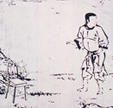Bookmarks — Looking for a Ship
Looking for a Ship is John McPhee’s short and beautifully written account of life aboard a merchant ship. He sailed on the S.S. Stella Lykes during a 42-day run down the Atlantic coast of the United States, through the Panama Canal, and on to South America. Along the way, he learned about navigation systems, cribbing horses, storms, stowaways, Charles Darwin, shipwrecks, and the lives of the men in the merchant marine. Any paragraph can become a point of departure. Consider this passage:
…the ship itself was making money running slow, because we were ahead of schedule. Seventy-one revolutions per minute. Fifteen knots. Undertime. Even so, she was consuming a gallon of bunker fuel every five seconds, a barrel every three and a half minutes. Three hundred thousand dollars had bought enough fuel to get us from Charleston to Chile and back. Mac said, “When we get up to maximum speed is when she just drinking like water.” The captain never goes higher than eighty-eight r.p.m., which makes about nineteen knots. Andy looked up from his weather reports, and his fingers began to tap a calculator. That would be fifty-nine gallons a mile, he told us — seventeen thousandths of a mile per gallon.
That got me thinking. Ninety feet per gallon is actually pretty good mileage — or perhaps I should say, footage. A luxury liner gets about thirty feet per gallon. Conventionally powered warships at flank speed get less than that. An Abrams tank with a gas turbine engine travels about 1,700 feet on a gallon of fuel. A tank with a diesel engine gets nearly one mile per gallon. When the U.S. prepares for war, fuel makes up 70% of cargo tonnage. Racing across the sand and flying above it during Desert Storm, U.S. forces consumed well over one million gallons of fuel per day.
History is often closer than we think, and McPhee’s book reminded me that I already knew another interesting detail about the Lykes Line that I acquired from a very different body of work. In 1959, a Marine radar operator defected to the Soviet Union. He reached Russia by way Finland, and he reached Finland by sailing aboard the S.S. Marion Lykes. He bought his ticket at the Lykes Line offices in the New Orleans International Trade Mart. When he re-defected to the United States, the State Department loaned him the money to travel. In 1963, he was accused of killing the President of the United States and was executed in the basement of the Dallas police station. Maybe you’ve heard of him.
…the ship itself was making money running slow, because we were ahead of schedule. Seventy-one revolutions per minute. Fifteen knots. Undertime. Even so, she was consuming a gallon of bunker fuel every five seconds, a barrel every three and a half minutes. Three hundred thousand dollars had bought enough fuel to get us from Charleston to Chile and back. Mac said, “When we get up to maximum speed is when she just drinking like water.” The captain never goes higher than eighty-eight r.p.m., which makes about nineteen knots. Andy looked up from his weather reports, and his fingers began to tap a calculator. That would be fifty-nine gallons a mile, he told us — seventeen thousandths of a mile per gallon.
That got me thinking. Ninety feet per gallon is actually pretty good mileage — or perhaps I should say, footage. A luxury liner gets about thirty feet per gallon. Conventionally powered warships at flank speed get less than that. An Abrams tank with a gas turbine engine travels about 1,700 feet on a gallon of fuel. A tank with a diesel engine gets nearly one mile per gallon. When the U.S. prepares for war, fuel makes up 70% of cargo tonnage. Racing across the sand and flying above it during Desert Storm, U.S. forces consumed well over one million gallons of fuel per day.
History is often closer than we think, and McPhee’s book reminded me that I already knew another interesting detail about the Lykes Line that I acquired from a very different body of work. In 1959, a Marine radar operator defected to the Soviet Union. He reached Russia by way Finland, and he reached Finland by sailing aboard the S.S. Marion Lykes. He bought his ticket at the Lykes Line offices in the New Orleans International Trade Mart. When he re-defected to the United States, the State Department loaned him the money to travel. In 1963, he was accused of killing the President of the United States and was executed in the basement of the Dallas police station. Maybe you’ve heard of him.


<< Home